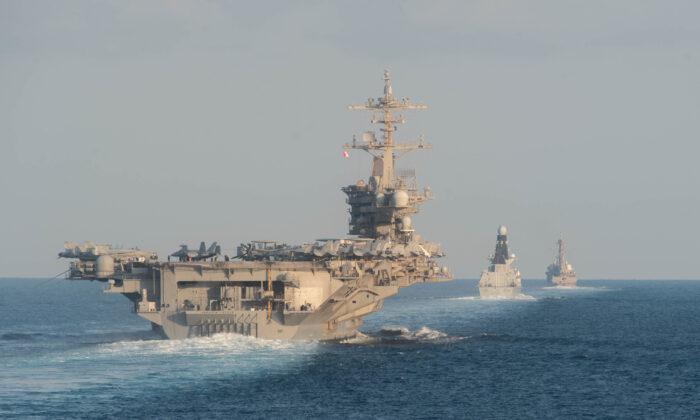The U.S. Navy said it intervened in two separate incidents on July 5 to block Iranian vessels from attempting to seize two oil tankers near the Strait of Hormuz, which separates Iran from the Arabian Peninsula.
“The Iranian navy did make attempts to seize commercial tankers lawfully transiting international waters,” Cmdr. Tim Hawkins, a spokesman for the Navy’s Fifth Fleet, said in a statement to several news outlets. “The U.S. Navy responded immediately and prevented those seizures.”
The Iranian vessels, the U.S. Navy said, fired at one of the tankers as part of the second attempt; no damage or casualties were reported, officials said.
Both incidents took place in waters between Iran and Oman, the Navy said.
Cmdr. Hawkins didn’t say how the U.S. Navy prevented the seizure of the ships or provide any further information. Details regarding the second tanker weren’t immediately clear.
Oil giant Chevron said that one incident involved the Richmond Voyager, a large crude oil carrier managed by the company. The crew onboard the ship is safe, the company said.
A Chevron spokesperson said “there is no loss of life, injury, or loss of containment” aboard the Richmond Voyager.
“The vessel is operating normally. The safety of our crew is our top priority.”

British maritime security company Ambrey said a warship with a multinational navy task group was in the area at the time and had requested that the Iranian navy to “cease harassing” one of the merchant ships.
The Iranian regime hasn’t yet commented on the allegations. No statements were published to state-run affiliated news outlets as late on July 5.
Since 2019, there has been a series of attacks on shipping in strategic Gulf waters at times of tension between the United States and Iran, and the country seized two oil tankers within a week just over a month ago, the U.S. Navy said.
A prior incident occurred six days before that when the Iranian navy seized the oil tanker Advantage Sweet while it was transiting international waters in the Gulf. It had departed Mina Saud Port in Kuwait and was heading to Houston while being commissioned by Chevron.
The Fifth Fleet at the time said that it was “working with regional allies and partners to increase the rotation of ships and aircraft patrolling in and around the Strait of Hormuz following Iran’s recent unlawful merchant vessel seizures.” A Navy official, meanwhile, said that Tehran is engaging in “irresponsible” and “unlawful” actions targeting merchant oil tankers, which “must stop,” according to a news release.
Navy officials said in the release that Iran has harassed, attacked, or interfered with about 15 internationally flagged merchant vessels over the past two years or so.

About a fifth of the world’s supply of crude oil and related products passes via the Strait of Hormuz, described as a choke point between Oman and Iran that connects the Gulf of Oman with the Persian Gulf, according to data from the firm Vortexa, reported Reuters.
While relations between the United States and Iran have been poor since the 1979 revolution and regime change, tensions have risen since the United States pulled out of Iran’s 2015 nuclear agreement with other world powers. Iran has attempted to resume its nuclear activities while claiming they are for peaceful purposes, and it has also provided drones to Russia for the war in Ukraine.





